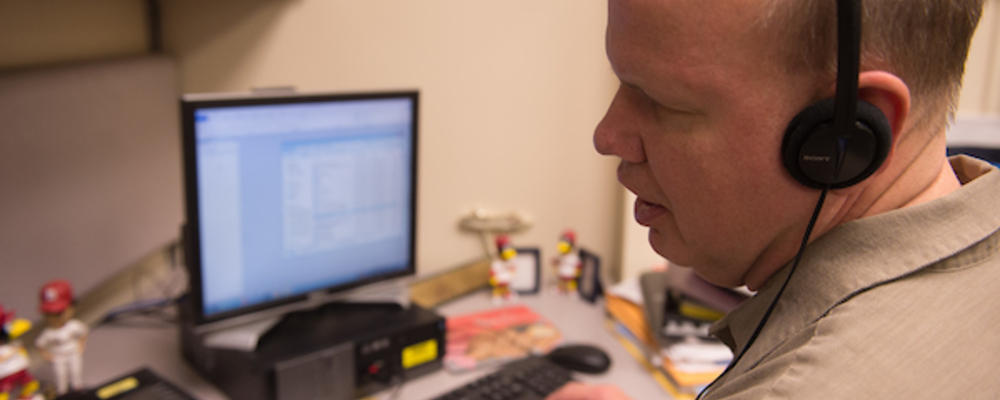
The University of Iowa ranks first in the nation in an assessment of how accessible its websites are to people with disabilities.
UI topped the list of 140 American universities, according to rankings presented at an Educause conference poster session by Dr. Jon Gunderson of the Division of Disability Resources and Education Services at the University of Illinois-Champaign/Urbana.
Gunderson uses a tool called the Functional Accessibility Evaluator (FAE) 2.0 to measure compliance with W3C Web Content Accessibility Guidelines 2.0, which make sites accessible to people with vision and hearing impairment, learning and speech disabilities, and cognitive and mobility limitations.
A remarkable rise
The No. 1 ranking marks a dramatic improvement from Gunderson’s last assessment, conducted in 2009, when UI ranked near last. The moment UI learned it was lagging in accessibility, a swift and concerted effort was made to address the issue—a multi-faceted strategy that involved developing campus-wide standards for Web accessibility, hiring an accessibility coordinator, offering training and consulting, raising awareness, conducting internal evaluations, and adopting a content-management system that supports accessibility.
“Technology is essential to nearly everything we do at the UI, and we are committed to providing an equivalent experience to all users, regardless of ability or access method,” says Associate Vice President and Chief Information Officer Steve Fleagle. “We have focused a lot of effort on this key initiative in recent years, and rising to the top in this ranking is an indication of the terrific progress we have made.”
The evaluation focuses on four areas of each institution’s Web presence: the home page, Admissions, College of Liberal Arts and Sciences, and the College of Education. It generates a score based on a number of key accessibility indicators from WCAG 2.0AA guidelines, such as text alternatives for images, labels for form fields, adequate contrast for text and visual components, and proper heading structure.
Culture change
Mike Hoenig (pictured above), a program coordinator in the Center for Disabilities and Development at UI Stead Family Children’s Hospital, counts on accessibility features to work efficiently in his job, which involves hosting a public access TV show on disability topics, training health science students to meet the needs of people with disabilities, and helping individuals with disabilities transition from state institutions to the community. Hoenig has been blind since birth, and uses a screen-reading program on the computer.
“If technology or websites aren’t accessible, my ability to do my job independently is compromised,” he says. “Someone else has to be assigned the task, or I have to ask for assistance, which means doubling up on something that I should be able to do independently.”
Hoenig, a 23-year UI veteran, has noticed the increased focus on technical accessibility on campus.
“Certainly the culture has changed,” he says. “People are now asking what they can do to make things accessible. I was recently asked to help test a new online tool prior to its rollout, and that was a wonderful thing. The culture of being proactive about this is getting a lot better.”
UI IT accessibility advocates are receiving far more requests for help and information.
“Every day, people come to us,” says Kirk Corey, director of policy and user services in the UI Information Security and Policy Office. “They are thinking ahead because accessibility is a priority.”
Progress through partnership
Partnerships were important to the UI’s strides in accessibility.
“Accessibility aligns with a culture of inclusiveness that is prominent on campus,” says IT Accessibility Coordinator Todd Weissenberger. “As we worked to raise awareness, we saw an eagerness to learn.”
Partners included both Student and Faculty/Staff Disability Services, the Chief Diversity Office, the Disability Planning and Action Committee, the Office of the ADA Coordinator, and the General Counsel’s Office. Website owners and developers, communication staff, and media producers were instrumental in the progress, as were the many UI executives who demonstrated support for accessibility initiatives.
Dawn Hanna, web coordinator for the College of Education, is one example of a UI employee who embraced accessibility. She took the initiative to share with other on campus the best practices she was learning and applying in her own college, and received an Above and Beyond Award for her efforts.
Drupal makes a difference
Getting the majority of campus on a common content management system, Drupal, was also impactful.
Drupal allows Web developers to work from templates that can be customized, and certain accessibility properties and characteristics are built in from the onset of the site. The Web Services Team in Information Technology Services built accessibility features into its standard service templates, and as early adopters of the concepts played a key role in moving accessibility from policy to practice.
More than 100 UI sites are tested regularly for accessibility, and reports are distributed to the owners.
Accessibility resources
The Web accessibility team emphasizes that accessibility is an ongoing process, and there is more work to be done. The team is always willing to assist campus with training and awareness, consulting, assessment, and interpretation of rules. Additional accessibility resources available.
“The No. 1 ranking is great news—it feels like we’ve won the championship this year,” Corey says. “But next year we still want to see a good team. We have to come back and do a really good job again."
Story by Nicole Dahya, Information Technology Services; Photo by Tim Schoon, Office of Strategic Communication